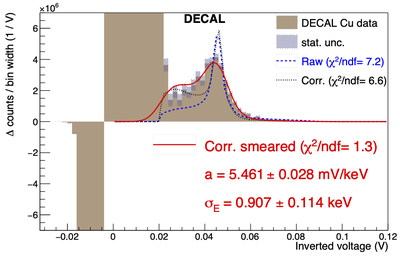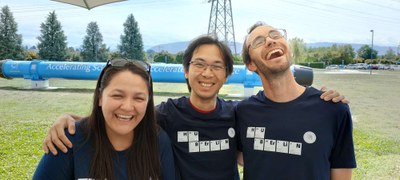The latest news from our group.
(dated October 3,2025)
Erfolgreiche Promotion von Frédéric Renner
Am 9. September 2025 hat Frédéric Renner seine Dissertation zum Thema „Automated Optimization of an ATLAS Search for Higgs Boson Pair Production at the LHC“ erfolgreich verteidigt.
Wir gratulieren herzlich zu diesem wichtigen wissenschaftlichen Meilenstein und wünschen ihm weiterhin viel Erfolg auf seinem Forschungsweg.
I was always interested in the structure of things’: particle physicist Çiğdem İşsever on the importance of thinking about physics early
(dated June 17, 2024)
„Speziell für die Suche nach extrem schwach wechselwirkenden Teilchen“
(dated July 23, 2024)
Latest studies on the DECAL sensors published in Frontiers in Physics
(dated October 18, 2023)
Members of Prof. Issever’s and Prof. Worm’s working group, together with colleagues at several UK institutes, just published their latest results on measurements of the DECAL sensor in Frontiers in Physics: Front. Phys. 11 (2023) 1231336. The publication can be found here.
The DECAL sensor is a monolithic active pixel sensor designed for digital calorimetry. Our research aims to understand how suitable these types of sensors are for their operation in calorimetry and how well digital calorimeters will perform at future collider experiments compared to their analog counterparts.
The main results of this publication is the energy calibration of the sensor through absorption of X-rays from fluorescence and radioactive sources. Using the energy spectrum of the X-ray absorption and comparing it to the signals obtained in the DECAL sensor, we were able to extract that DECAL measures a signal strength of 5.54 ±0.37 milli-volt per kilo-electronvolt of absorbed energy. We also measured the relative energy resolution (that is relative uncertainty of the energy measurement) to be 11.8± 3.0%.
These studies were spearheaded by Lucian Fasselt, who had been a master’s student in Prof. Issever’s group and now is a graduate student in Prof. Worm’s working group.

Spectrum of the “inverted” voltage obtained through scanning the threshold for accepting a signal under X-ray fluorescence with a copper target. The dashed blue line indicates the “true” energy spectrum measured with a high-precision detector, the dashed black line corrects this spectrum for the photon absorption probability in the sensor. Both lines are fitted to the data of the DECAL sensor (brown histogram). The corrected red curve incorporates a smearing to account for the energy resolution of the DECAL sensor.
Note, that the two big blocks around the “inverted” voltage = 0 (the so-called baseline of the sensor) are due to the expected intrinsic noise in the sensor, the true signal can be found when the threshold is set 20 milli-volts below the baseline (inverted voltage bigger than 20 milli-volts).
The results characterize the functionality of the digital sensor. Further studies are prepared to investigate the charge distribution within a pixel, that is a single readout unit of the sensor. The aim is to obtain a three dimensional profile of the sensitive geometry of the pixel by using a laser setup with micrometer position precision.
Three members take up new coordination roles within the ATLAS experiment
(dated October 1, 2023)
The ATLAS experiment is one of the four big experiments at the Large Hadron Collider at CERN. Its 3000 scientific collaborators study the properties of the fundamental particles, including the newly discovered Higgs boson, at the highest precision and search for undiscovered physics phenomena beyond the Standard Model.
In order for such a big collaboration to work efficiently, all aspects of the experimental programme need to be well organized. The many interlocking activities, including operation of the various detector systems, processing of the collected data for subsequent analysis, identification and measurement of particle signals, and studies of particular physics processes, are divided into ‘Activity Areas’ and ‘Working Groups’. In these groups, experts can focus on specific tasks and challenges, while the experimental management facilitates communication and coordination across these different areas.
The ATLAS collaboration selected members of the Prof. Issever’s working group to coordinate three such major fields of activity starting October 1st, 2023:
- Dr. Arely Cortes Gonzalez will lead the working group studying ATLAS physics data to search for new physics processes using Higgs and DiBoson Signatures (HDBS). Such processes include the rare production of pairs of Higgs bosons, as well as new particles beyond the predictions of the Standard Model
- Dr. Daniel Guest will lead the ATLAS Flavour Tagging working group that develops and calibrates the algorithms that identify jets of particles produced by ‘heavy flavour’ bottom and charm quarks. These are important for studying many heavy particles, including top quark and Higgs boson.
- Dr. Teng Jian Khoo was elected to be the Deputy ATLAS Trigger Coordinator, and will be responsible for the ‘trigger’ systems that select LHC collision events for data analysis. The trigger group optimises a ‘menu’ of event selections to feed the ATLAS physics programme and operates the trigger while the ATLAS detector is taking data. He will be promoted to Trigger Coordinator the following year.

In the picture from left to right: Dr. Arely Cortes Gonzalez, Dr. Teng Jian Khoo, and Dr. Daniel Guest
